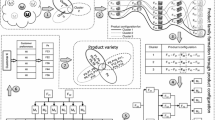Abstract
Platform has been known as an effective strategy for trading off between product customization and economies of scale, and firms have paid more and more attention to designing an effective and efficient product platform. In platform designing, modularity strategy is usually adopted and new modules are introduced to maintain the variety of products and flexibility of the platform. However, production costs and failure rates of new modules are usually uncertain due to the lack of historical data. Besides, the values of some key parameters in platform design, such as cost saving from designing a modular platform and demand quantity of the products, are also often vague. In this paper, we study the problem of designing a product platform with modularity strategy under fuzzy environment. By characterizing the cost saving from designing a modular platform, the demand quantity of the products and the parameters representing economies of scale and product quality improvement as fuzzy variables, we formulate three fuzzy programming models. An efficient algorithm combining fuzzy simulation and simulated annealing is proposed to solve the models. Numerical experiments are conducted to show the performance of the algorithm.








Similar content being viewed by others
References
Alberto J, Tollenaere M (2005) Modular and platform methods for product family design: literature analysis. J Intell Manuf 16(3):371–390
Bruno A, Bassetto S (2013) Modular design of product families for quality and cost. Int J Prod Res 51(6):1648–1667
Ben-Arieh D, Easton T, Choubey AM (2009) Solving the multiple platforms configuration problem. Int J Prod Res 47(7):1969–1988
Du G, Jiao RJ, Chen M (2014) Joint optimization of product family configuration and scaling design by stackelberg game. Eur J Oper Res 232(2):330–341
Du JM, Yu LA, Li X (2016) Fuzzy multi-objective chance-constrained programming model for hazardous materials transportation. Int J Gen Syst 45(3):286–310
Farrell RS, Simpson TW (2003) Product platform design to improve commonality in custom products. J Intell Manuf 14(6):541–556
Gao J, Yu Y (2013) Credibilistic extensive game with fuzzy payoffs. Soft Comput 17(4):557–567
Jiao JR, Zhang Y, Wang Y (2007) A heuristic genetic algorithm for product portfolio planning. Comput Oper Res 34(6):1777–1799
Karl U (1995) The role of product architecture in the manufacturing firm. Res Policy 24(3):419–440
Li H, Azarm S (2002) An approach for product line design selection under uncertainty and competition. J Mech Des 124(3):385–392
Liu B (2004) Uncertainty theory: an introduction to its axiomatic foundations. Springer, Berlin
Liu B, Liu YK (2002) Expected value of fuzzy variable and fuzzy expected value models. IEEE Trans Fuzzy Syst 10(4):445C450
Liu B, Zhao R, Wang G (2003) Uncertain programming with applications. Press of Tsinghua University, Beijing
Lu M (2014) On crisp equivalents and solutions of fuzzy programming with different chance measures. Biol Lett 10(6):691–692
Martin S, Karlsson C (2012) Product platform replacements: challenges to managers. Int J Oper Prod Manag 32(6):746–766
Meyer MH, Lehnerd AP (1997) The power of product platforms. Simon and Schuster. Int J Mass Cust 1(13):1–13
Ni Y (2008) Fuzzy minimum weight edge covering problem. Appl Math Model 32(7):1327–1337
Ni Y, Zhao Z (2017) Two-agent scheduling problem under fuzzy environment. J Intell Manuf 28(3):739–748
Olivares-Benitez E, Gonzalez-Velarde JL (2008) A metaheuristic approach for selecting a common platform for modular products based on product performance and manufacturing cost. J Intell Manuf 19(5):599–610
Qu T et al (2011) Two-stage product platform development for mass customisation. Int J Prod Res 49(8):2197–2219
Simpson TW (2004) Product platform design and customization: status and promise. Artif Intell Eng Des Anal Manuf 18(1):3–20
Suryakant S (2015) Tyagi, optimization of a platform configuration with generational changes. Int J Prod Econ 169:299–309
Souma C, Messac A, Khire RA (2011) Comprehensive product platform planning (cp3) framework. J Mech Des 133(10):101004
Tarang A et al (2013) A hybrid model of component sharing and platform modularity for optimal product family design. Int J Prod Res 51(2):614–625
Vish K, Gupta S (2001) Appropriateness and impact of platform-based product development. Manag Sci 47(1):52–68
Yang L, Zhou X, Gao Z (2013) Rescheduling trains with scenario-based fuzzy recovery time representation on two-way double-track railways. Soft Comput 17(4):605–616
Yigit AS, Ulsoy AG, Allahverdi A (2002) Optimizing modular product design for reconfigurable manufacturing. J Intell Manuf 13(4):309–316
Yigit AS, Ulsoy AG, Allahverdi A (2003) Optimal selection of module instances for modular products in reconfigurable manufacturing. Int J Prod Res 41:4063–4074
Zadeh LA (1965) Fuzzy sets. Inf Control 8(3):338–353
Acknowledgements
This work was supported by National Natural Science Foundation of China (No. 71471038) and Program for Huiyuan Distinguished Young Scholars, UIBE.
Author information
Authors and Affiliations
Corresponding author
Ethics declarations
Conflicts of interest
Qinyu Song declares that she has no conflict of interest. Yaodong Ni declares that he has no conflict of interest.
Ethical approval
This article does not contain any studies with human participants or animals performed by any of the authors.
Additional information
Communicated by V. Loia.
Rights and permissions
About this article
Cite this article
Song, Q., Ni, Y. Optimal platform design with modularity strategy under fuzzy environment. Soft Comput 23, 1059–1070 (2019). https://doi.org/10.1007/s00500-017-2828-8
Published:
Issue Date:
DOI: https://doi.org/10.1007/s00500-017-2828-8




